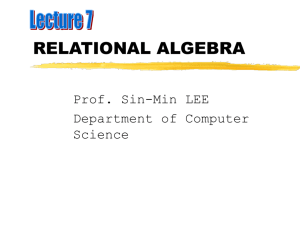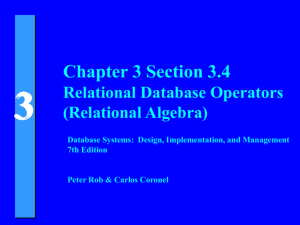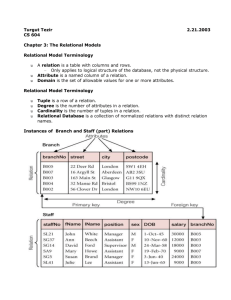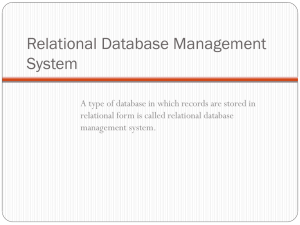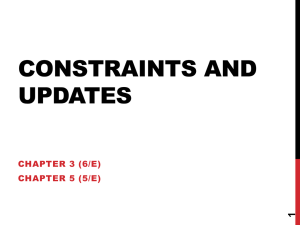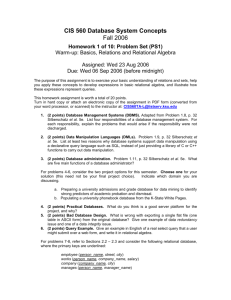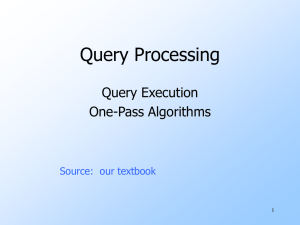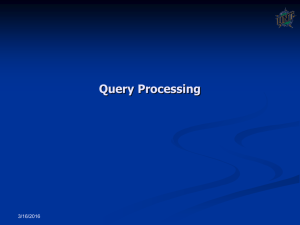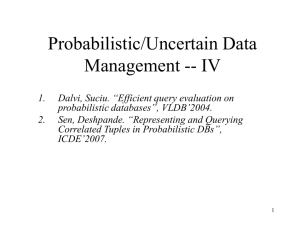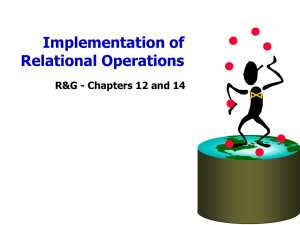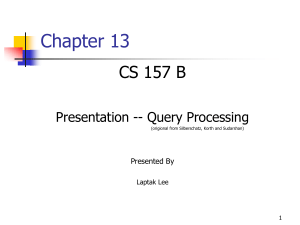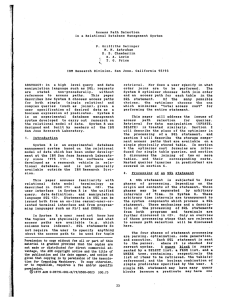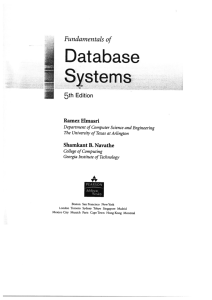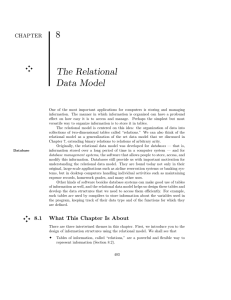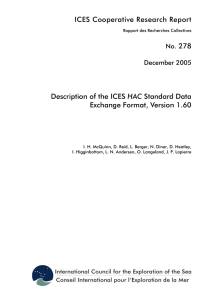Query Language #1/3: Relational Algebra Pure, Procedural
advertisement
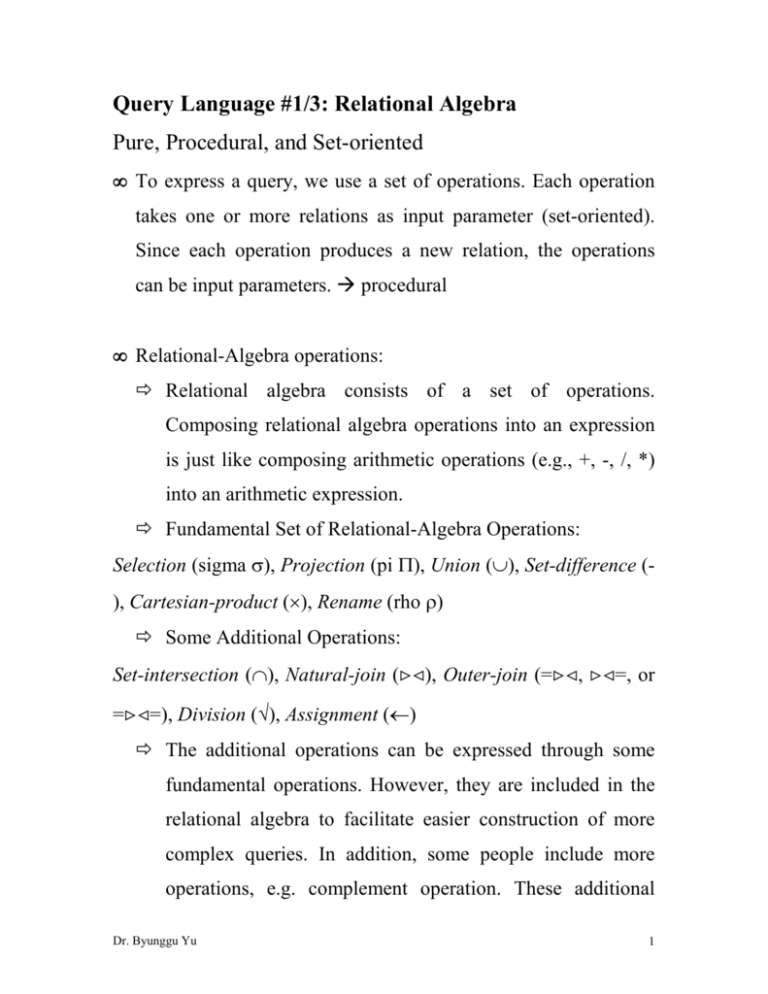
Query Language #1/3: Relational Algebra
Pure, Procedural, and Set-oriented
• To express a query, we use a set of operations. Each operation
takes one or more relations as input parameter (set-oriented).
Since each operation produces a new relation, the operations
can be input parameters. procedural
• Relational-Algebra operations:
Relational algebra consists of a set of operations.
Composing relational algebra operations into an expression
is just like composing arithmetic operations (e.g., +, -, /, *)
into an arithmetic expression.
Fundamental Set of Relational-Algebra Operations:
Selection (sigma σ), Projection (pi Π), Union (∪), Set-difference (), Cartesian-product (×), Rename (rho ρ)
Some Additional Operations:
Set-intersection (∩), Natural-join (><), Outer-join (=><, ><=, or
=><=), Division (÷), Assignment (←)
The additional operations can be expressed through some
fundamental operations. However, they are included in the
relational algebra to facilitate easier construction of more
complex queries. In addition, some people include more
operations, e.g. complement operation. These additional
Dr. Byunggu Yu
1
operations do not improve the expressive power of relational
algebra.
• Selection (sigma σ)
Unary operation on a relation r(R), which produces a
relation r'(R) ⊆ r(R).
Let F be a predicate Ai = a, where Ai is an attribute name
in R and a is a value in the domain of Ai. Then, σF(r) = {t |
t∈r ∧ t[Ai] = a}.
Predicate can involve:
Constant and attributes;
Comparative operators: =, >, <, ≤, ≥, and ≠;
Logical operators: ∧, ∨, and ¬;
Parenthesis: ( and ).
Example1
r
A
1
2
3
B
b1
b2
b2
C
c1
c1
c2
σA>1 ∧ A < 3(r)
A
2
B
b2
C
c1
Example2
σbranch-name="Laramie" ∧ balance>2000 (account)
Dr. Byunggu Yu
2
• Projection (pi Π)
ΠX(r) is an unary operation on a relation r(R), which
produces a relation r'(X) in which X ⊆ R. Any duplicate
tuple is eliminated.
ΠX(r) = {t (X⊆R) | t∈r}
Generalized Projection:
X can be F1, F2, …, Fn;
Each F can be:
an attribute or an arithmetic expression
(e.g., balance, balance*0.3, balance-limit)
Example1
r
A
1
2
3
B
b1
b2
b2
C
c1
c2
c2
ΠB,C(r)
B
b1
b2
C
c1
c2
Example2
Πaccount#, balance (account)
Πaccount#, balance*0.25 (account)
Dr. Byunggu Yu
3
• Union (∪)
Set r(R) ∪ s(S) is a relation q(R), which contains tuples
from r or from s. Any duplicate tuple is eliminated. R and
S must be the same.
r(R) ∪ s(S) = {t | t∈r ∨ t∈s}
Example
r
A
1
2
3
B
b1
b2
b2
C
c1
c2
c2
s
B
b1
b4
C
c1
c5
ΠB, C(r) ∪ s
B
b1
b2
b4
C
c1
c2
c5
Dr. Byunggu Yu
4
• Set-difference (-)
Set r(R) - s(S) is a relation q(R), which contains tuples in r
that are not in s. R and S must be the same.
r(R)-s(S) = {t | t∈r ∧ t∉s}
Example
r
A
1
2
3
B
b1
b2
b2
C
c1
c2
c2
s
B
b1
b4
C
c1
c5
ΠB, C(r) - s
B
b2
C
c2
Dr. Byunggu Yu
5
• Cartesian-product (×)
Set r(R) × s(S) is a relation q(Q) whose schema Q is the
concatenation of R and S.
r(R) × s(S) = {t (Q=R+1S) | ∃t1∈r (t[R] = t1) ∧ ∃t2∈s (t[S]
= t2)}
Example
r
A
1
2
3
B
b1
b2
b2
C
c1
c2
c2
s
B
b1
b4
C
c1
c5
r×s
A
1
1
2
2
3
3
r.B
b1
b1
b2
b2
b2
b2
Dr. Byunggu Yu
r.C
c1
c1
c2
c2
c2
c2
s.B
b1
b4
b1
b4
b1
b4
s.C
c1
c5
c1
c5
c1
c5
6
• Rename (rho ρ)
ρx(r), whose r is on relation schema R, is an unary
operation that returns a relation x(R).
If one use ρx(A1, A2, …, An)(r) then the attributes of R are
renamed to A1, A2, …, An.
Example
r
B
b1
b4
C
c1
c5
r × ρs(D)(ΠC(r))
B
b1
b1
b4
b4
1
C
c1
c1
c5
c5
D
c1
c5
c1
c5
Concatenation
Dr. Byunggu Yu
7
• Set-intersection (∩)
Set r(R) ∩ s(S) is a relation q(R) that contains common
tuples in r and s after removing the duplicates. R and S
must be the same.
r(R) ∩ s(S) = {t | t∈r ∧ t∈s}
Example
r
A
1
2
3
B
b1
b2
b2
C
c1
c2
c2
s
B
b1
b4
C
c1
c5
ΠB, C(r) ∩ s
B
b1
C
c1
Dr. Byunggu Yu
8
• Natural-join (><)
Set r(R) >< s(S) is a relation q(Q) whose schema Q is the
union of R and S. Every tuple in relation q satisfies (t∈q
∧t[Q∩R]∈r ∧ t[Q∩S]∈s)
r(R) >< s(S) = {t (Q=R∪S) | t[Q∩R]∈r ∧ t[Q∩S]∈s} =
Π R∪S(σr.A1=s.A1∧r.A2=s.A2∧…∧r.An=s.An r×s) where R∩S = {A1,
A2, …, An}.
We can give a simple or composite predicate θ on
attributes in R+2S, i.e. r ><θ s (theta join).
Example
r
A
1
2
3
B
b1
b2
b2
C
c1
c2
c2
s
B
b1
b4
C
c1
c5
r >< s
A
1
2
B
b1
C
c1
concatenation
Dr. Byunggu Yu
9
• Outer-join (Left outer-join: =><, Right outer-join: ><=, and full
outer-join: =><=)
r(R) =>< s(S): takes all tuples in r that did not match with
any tuple in s, pads the tuples with null values for the
attributes S-R, and adds them to the result of the natural
join.
r(R) ><= s(S): takes all tuples in s that did not match with
any tuple in the r, pads the tuples with null values for the
attributes R-S, and adds them to the result of the natural
join.
r(R) =><= s(S) = r(R) =>< s(S) ∪ r(R) ><= s(S)
Example
r
A
1
2
3
B
b1
b2
b2
s
B
b1
b4
D
d1
d2
r =>< s
A
1
2
3
B
b1
b2
b2
Dr. Byunggu Yu
D
c1
null
null
10
• Division (÷)
Set r(R) ÷ s(S) is a relation q(Q) satisfying the following
conditions:
(1) S ⊆ R ∧ Q=R-S
(2) t∈q ∧∀ts ∈ S (∃tr ∈ R (tr[S]=ts ∧ tr[R-S] = t))
r(R) ÷ s(S) = {t(Q=R-S) | ∀ts ∈ s (∃tr ∈ r (tr[S]=ts ∧ tr[R-S]
= t))}
Example
r
A
1
1
3
B
b1
b4
b2
C
c1
c5
c2
s
B
b1
b4
C
c1
c5
r÷s
A
1
Dr. Byunggu Yu
11
• Assignment (←)
Assignment to temporary relation variable: A query can be
written as a sequential program.
e.g., temp1 ← ΠR-S(r)
temp2 ← ΠR-S((temp1 × s) - r)
temp1 - temp2
vs.
ΠR-S(r) - ΠR-S((ΠR-S(r) × s) - r)
Assignment to permanent relation: used to express
database modification (insertion, deletion, update).
e.g., Insertion: account ← account ∪ {("Laramie", 28345, 5000)}
Deletion: account ← account - σaccount#=28345(account)
Update: account ← Πbranch-name, account#, balance*1.05(account)
account ← σaccount#≠28345(account) ∪
Πbranch-name, account#, balance*1.05(σaccount#=28345(account))
Dr. Byunggu Yu
12
Query Language #2/3: Tuple Relational Calculus
Pure, Non-procedural, Relational
We describe what we want without how to obtain it.
Specifically, {t | P(t)}, where "t" means "result tuple", is read as:
“(I want) The set of all tuples t such that the query predicate P is
true for t.”
e.g.1 {t | t ∈ account ∧ t[balance] > 1200}
Note, t[A] denote the values of tuple t on attribute (or attributes) A
e.g. 2 {t | ∃a ∈ account (t[account#] = a[account#] ∧
a[balance] > 1200)}
Note, the difference between e.g.1 and e.g.2 is that the result of
e.g.2 consist of only one attribute "account#"
e.g. 3 {t | ∃c ∈ checking (t[customer#] = c[customer#]) ∧
∃s ∈ saving (t[customer#] = s[customer#])
}
e.g. 4 {t | ∃c ∈ checking (t[customer#] = c[customer#]) ∧
∃s ∈ saving (t[customer#] = s[customer#]) ∧
¬∃l ∈ loan (t[customer#] = l[customer#])
}
Dr. Byunggu Yu
13
e.g. 5 {t | ∀b ∈ branch (b[branch-city] = "Laramie" =>
∃a ∈ acc-cust (t[customer#] = a[customer#]) ∧
a[branch#] = b[branch#]
)
)
}
Note, P1 => P2 means "P1 implies P2” or “if P1 is true then P2 must be
true" (P2 is the superset of P1). (P1 => P2) ≡ ¬(P1 ∧ ¬P2) ≡ (¬P1 ∨ P2)
Dr. Byunggu Yu
14
Query Language #3/3: Domain Relational Calculus
Pure, Non-procedural, Relational
Domain calculus is the same as tuple calculus except that the
expression is always "domain-oriented" (attribute-oriented).
Specifically, {<x1, x2, …, xn> | P(x1, x2, …, xn)} where x1, x2,
…, and xn are the 1st, 2nd, …, and 3rd attribute values of a result
tuple, respectively.
e.g.1 find every tuple, whose balance is greater than 1200, from
"account" relation: {<a, b, c> | <a, b, c> ∈ account ∧ b > 1200}
e.g.2 {<a> | ∃b, c(<a, b, c> ∈ account ∧ b > 1200)} Same as e.g.1
except that we want only "account#".
e.g.3 {<c> | ∃a, b, o (<a, b, c, o> ∈ checking) ∧
∃a, b, i (<a, b, c, i> ∈ saving)
}
Note, 'a' stands for account#, 'b' for balance, 'c' for customer#, 'o'
for overdraft-amount, and 'i' for interest-rate
Dr. Byunggu Yu
15
e.g. 4 {<c> | ∃a, b, o (<a, b, c, o> ∈ checking) ∧
∃a, b, i (<a, b, c, i> ∈ saving) ∧
¬∃a, l (<l, a, c> ∈ loan)
}
Note, 'l' stands for loan# and a for loan-amount
e.g. 5 {<c> | ∀b, c1 (<b, c1> ∈ branch ∧ c1 = "Laramie" =>
∃a (<a, c, b> ∈ acc-cust)
)
}
Note, 'b' stands for branch#, 'c1' stands for branch-city, and 'a'
stands for account#.
A dot (.) in a predicate is used to indicate that the scope of
the preceding quantifier extends to the end of the entire
predicate. This is a convenient way to eliminate deep
nesting of parenthesis.
Note, people generally agree with that the expressive
powers of all three relational languages are the same.
Dr. Byunggu Yu
16
1. View
A view is a virtual relation that is made visible to a user
(or a group of users) but does not exist in logical level
database (recall the three level schema). We define a view
with a query expression.
e.g., create view Checking_Customers as
Πc-name, customer#, account#, telephone#, address (customer >< checking-account)
Since a view is virtually a relation, it changes dynamically.
Therefore, in the preceding example, if we modify
customer or checking-account relations, view must be also
modified. If views exist physically, data redundancy and
inconsistency problems occur. Usually, DBMSs don’t store
views as actual relations but store their definitions.
However, if the underlying database has only the
definitions, whenever a view is used as a relation in a
query, each view name must be replaced by the query
expression in the view definition. That is, the view must be
recomputed every time. With this, the performance will
Dr. Byunggu Yu
17
deteriorate. Therefore, some people have proposed
materialized views. In this approach, views are actually
stored as physical relations. However, there are added
complexity and overhead for updates.
Since each view is a relation to the users, the users may
update their views. However, because of its complexity,
view modifications are generally not allowed.
Note, to users, views are relations.
Dr. Byunggu Yu
18
Structured Query Language (SQL)
• Commercial, Procedural + Non-procedural, Not always
relational
• Easy to use
• Based on both relational algebra and relational calculus.
(e.g.,
You
don't
explicitly
express
projection
operation…rather the operation is expressed in select
statement as what you want. In contrast, you express the
procedure in some complex queries, such as union of two
sub select statements, embedded select, …).
Details will be explained and discussed in LectureNote#4.
Dr. Byunggu Yu
19

